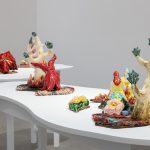In Dorsa Asadi’s Strange Fruit, the affective experience of living through the recent unrest in Iran and its long aftermath is translated into a tripartite Dantean arc. Each part of its narrative maps to a part of his epic allegorical poem the Divine Comedy, which served as a vision for what would become the modern Italian language. Fittingly, for a time in which Gen Z are increasingly the drivers of society, the main protagonists of these small ceramic works are the twins Elle and Belle, who have recurred in Asadi’s work for a number of years, like characters coming in and out of a party. Growing up in Iran, the artist was told that paradise is the reward for a life of gendered obedience. But the works here suggest that perhaps there might be other routes, and possibly even other languages too.
The fires of the past autumn are reflected in the high-contrast sanguine palette of the Inferno chapter. There is a sense of anger transposed to the chenar trees and nargis flowers and vines that bleed bloody tears and, along with Elle and Belle, threaten faceless pink men, holding them to the fire. Their grappling suggests a koshti or wrestling match, traditionally a very machismo display of submission and surrender. Pools of water, a reference to the ongoing droughts and farmer protests elsewhere in Iran, do nothing to put out the flames. Neither do the chenars, despite pleading moments of supplication as with Sinnerman, you oughta be prayin’ (2022). It’s not just people who are angry, but the Earth itself too.
Yet amidst the collective action and celebration of female sexuality ran an undercurrent of alienation—a sense of being alone in a crowd—which soon gave way to suspicion and a generalised lack of trust during the interminable winter that followed. As such, most of the figures in Inferno and Purgatory are seen alone. A greyness descends on the works in the second chapter, leached of colour much as participants became leached of hope. But here, the men aren’t antagonists anymore, as if they have been purified by the fire and healed by the nargis blooms. Figures sink into the soil and the water, sometimes overtaken by vines as in Daddy, come on, save my soul (2023), where tangled vegetation seems to seethe like a botanical brain; becoming part of the landscape like all those still under the soil from the days of the Iranian Revolution.
This is a narrative of generational rebellion against the forces of patriarchy and capitalism— aided by religion—that work in tandem to control women’s bodies just as they control nature, terraforming its wild abundance into sites of ordered, joyless reproduction: farms, fields, baby-making factories. Put another way, when people domesticated wheat, they also domesticated women. Asadi traces this entwined domination of women and land in the development of regional civilisations through Mesopotamian goddess Ishtar, whose sexuality becomes a taboo in the epic of Gilgamesh. But contra the linearity of patriarchal history, her Paradiso is both prologue and sequel. Humans mutate together with plants, putting down roots and supporting each other. Nobody is expelled from this particular Garden of Eden but rather coexist with fantastical pastelled abandon, free from taboo and societal mores.
Press release from Green Art Gallery, Dubai



